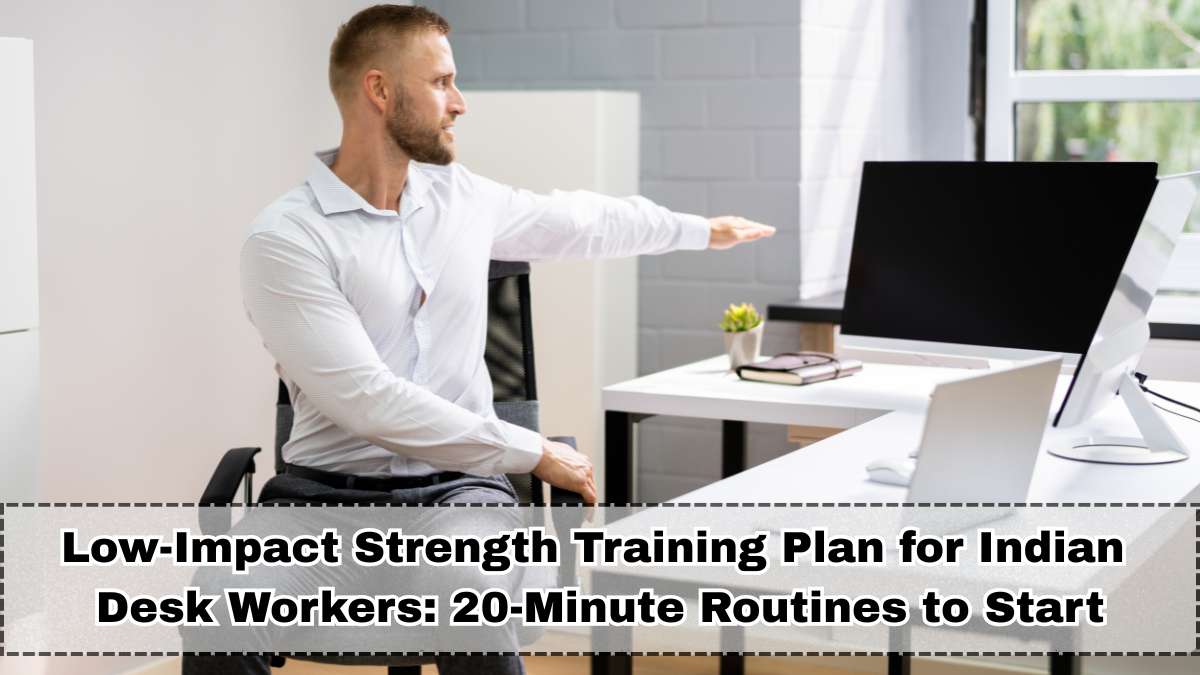Indian desk workers are sitting longer than ever in 2025. Long work hours, online meetings and deadlines leave very little time for movement. Over time, this causes stiffness, back pain, weak core muscles and low energy. That’s why a structured low impact strength training desk workers India routine is becoming essential for anyone who spends hours at a desk.
Strength training does not always mean heavy lifting or intense workouts. Low-impact routines are gentle on the joints, beginner-friendly and can be done in small spaces. These 20-minute sessions help build muscle, improve posture and reduce the aches caused by sedentary work.

Why Desk Workers Need Strength Training in 2025
Sitting for long hours weakens the glutes, tightens the hip flexors and strains the neck and back. This creates a misaligned posture that only gets worse with time. Strength training corrects these imbalances by activating underused muscles and improving mobility.
Low-impact workouts are especially important for Indian professionals dealing with knee pain, weight gain and stress. These routines are safe, effective and can be done without equipment, making them suitable for all age groups.
How Low-Impact Training Helps Reduce Desk-Job Pain
Weak muscles struggle to support the spine and joints. This leads to neck stiffness, rounded shoulders and lower back pain. Strength exercises strengthen these support systems and promote better alignment.
Improved muscle strength also enhances blood circulation, which reduces fatigue. People who follow low-impact routines often report better focus, higher energy and reduced brain fog throughout the day.
Essential Movements for Desk Workers
Glute bridges help reverse long hours of sitting by activating the hips and lower back. They create stability and reduce the pressure on the spine.
Wall push-ups are ideal for beginners who cannot perform floor push-ups yet. They strengthen the chest, shoulders and arms without straining the wrists or elbows.
Chair squats improve leg strength and mobility. Using a chair makes the movement safer for people with knee concerns.
Seated or standing rows using resistance bands help fix rounded shoulders and improve posture. These movements pull the shoulder blades back and reduce upper-back tightness.
20-Minute Daily Routine for Busy Professionals
Start with a light warm-up such as shoulder rolls and ankle circles. This loosens stiff joints and prepares the body for movement.
Spend the next 10–12 minutes on core and glute exercises. This includes planks, glute bridges, bird-dog and dead bugs. These movements target the areas most affected by long sitting hours.
Finish the routine with a few upper-body and lower-body strength moves. This can include wall push-ups, chair squats and resistance-band rows. Keep movements slow to maintain control and reduce impact on the joints.
Beginner-Friendly Dumbbell Routine for Home
If you have a pair of 2–5 kg dumbbells, you can level up your strength routine. Dumbbell deadlifts help strengthen the hamstrings and glutes without stressing the knees.
Bicep curls and shoulder presses improve arm strength for daily tasks. These exercises can be done while standing or seated, depending on comfort.
Dumbbell chest press on the floor helps activate the chest and upper back. It’s safer compared to bench press and perfect for small apartments.
How Often Desk Workers Should Train
Aim for at least 3–4 low-impact sessions per week. These routines are short enough to fit into lunch breaks or evenings after work. Consistency is more important than intensity, especially for beginners.
If you sit for long hours, add small micro-movement breaks throughout the day. Standing up, stretching or walking for 2 minutes every hour can significantly improve overall results.
Common Mistakes to Avoid
Rushing through movements reduces effectiveness and increases the risk of injury. Low-impact training works best when you move slowly and with proper control.
Another mistake is ignoring posture during the day. Even the best workout routine won’t help if you keep slouching at your desk. Adjust your chair height, screen level and arm position for long-term comfort.
Many beginners also skip warm-ups and cool-downs. These steps prevent stiffness and allow the muscles to recover properly.
Who Should Follow a Low-Impact Strength Routine
Anyone who spends more than 5–6 hours sitting should follow these routines. Desk workers, students, freelancers and remote employees benefit greatly from consistent strength training.
People with knee pain, lower-back issues or limited mobility should start with low-impact movements before trying more advanced workouts. These routines build a stable fitness base while protecting the joints.
FAQs
Can low-impact strength training build real muscle?
Yes. Slow, controlled movements activate muscles effectively without heavy weights.
How long before I see results?
Most people feel reduced stiffness and better posture within 2–3 weeks.
Do I need dumbbells to start?
No. Bodyweight exercises are enough for beginners.
Is low-impact training safe for knee pain?
Yes. These movements are joint-friendly and suitable for people with mild knee discomfort.
Can I do this routine during office breaks?
Absolutely. Most exercises need very little space and can be done at home or in the office.
Click here to know more.
